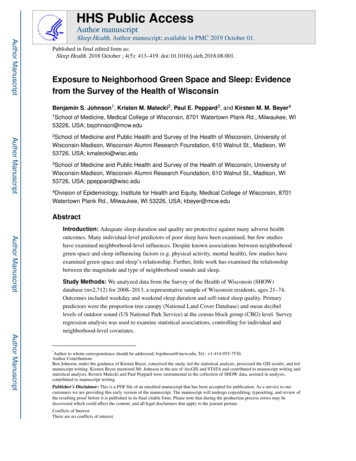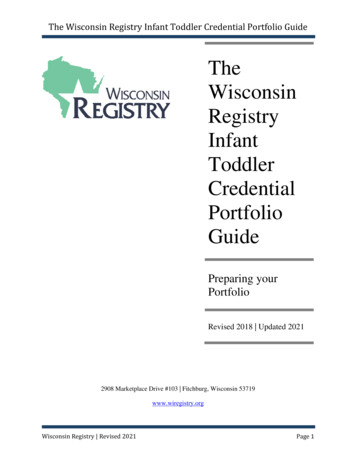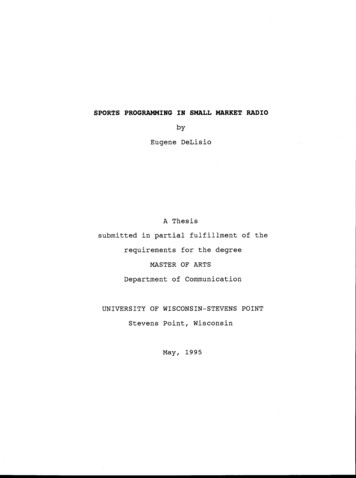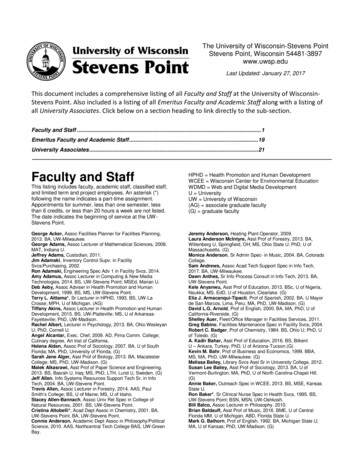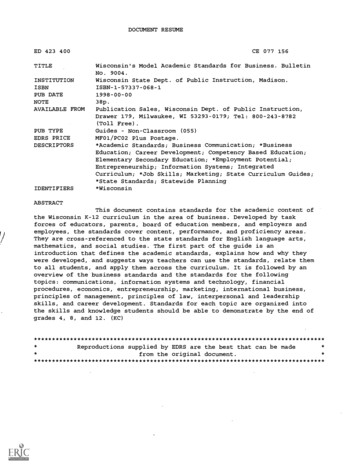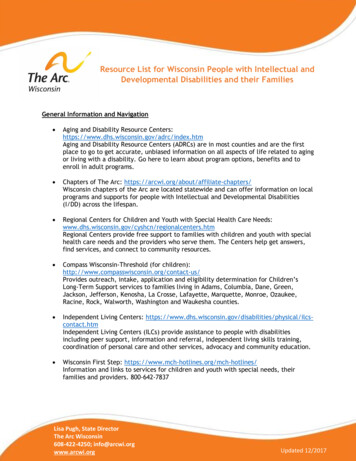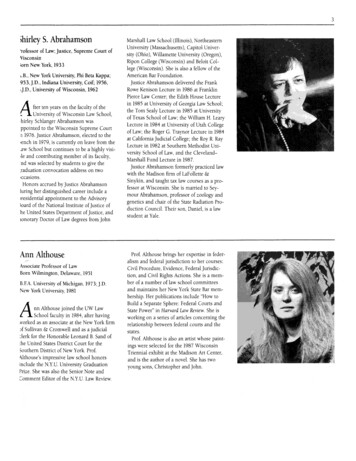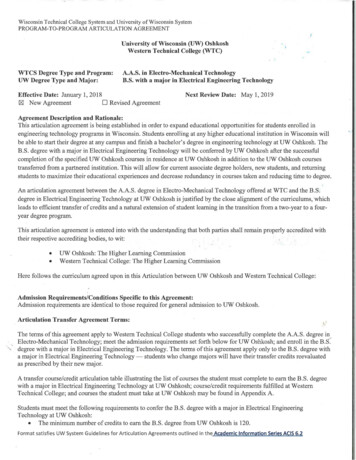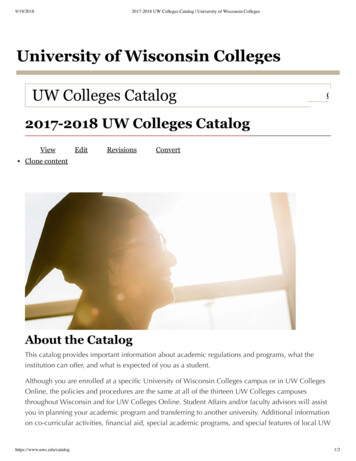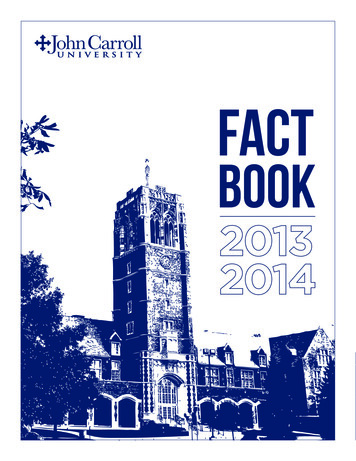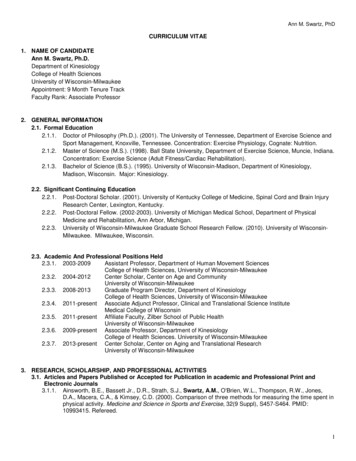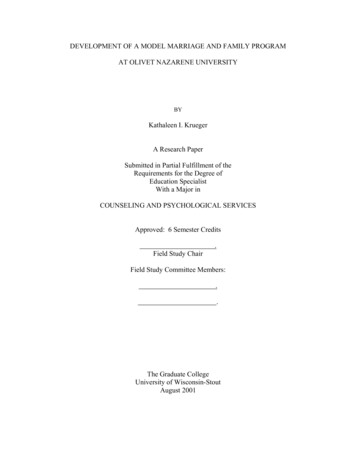
Transcription
DEVELOPMENT OF A MODEL MARRIAGE AND FAMILY PROGRAMAT OLIVET NAZARENE UNIVERSITYBYKathaleen I. KruegerA Research PaperSubmitted in Partial Fulfillment of theRequirements for the Degree ofEducation SpecialistWith a Major inCOUNSELING AND PSYCHOLOGICAL SERVICESApproved: 6 Semester Credits.Field Study ChairField Study Committee Members:.The Graduate CollegeUniversity of Wisconsin-StoutAugust 2001
iThe Graduate CollegeUniversity of Wisconsin-StoutMenomonie, WI 54751ABSTRACT(Writer)Krueger(Last Name)Kathaleen(First)I(Initial).DEVELOPMENT OF A MODEL MARRIAGE AND FAMILY PROGRAM ATOLIVET NAZARENE UNIVERSITY.(Title)Ed.S Counseling and Psychological Services(Graduate Major)August 2001(Month/Year)Dr. Edwin Biggerstaff(Research Advisor).( 71 )(No. of Pages).American Psychological Association (APA) Publication)(Name of Style Manual Used in this Study)This is not a scientific study with a specific population, data instrument,collection, analysis, and/or limitations. Rather it is descriptive in that this authorhas developed a model curriculum in Marriage and Family Therapy (MFT) forOlivet Nazarene University.Olivet Nazarene University began in 1907 offering education with aChristian purpose. It is accredited by the North Central Association of Collegesand approved by the State Department of Education in Illinois for both theirbachelors and masters programs. Using their “Lock-step” approach makes it.
iipossible for 12-15 students to progress through ONU’s masters programstogether. Classes are offered in the evening to better serve their clientele’s busyworking schedules.Olivet Nazarene University provides a Master of Arts in ProfessionalCounseling Program and is in an excellent position to add a Marriage and FamilyTherapy curriculum/program to their Graduate and Adult Studies Program. AMarriage and Family Therapy Program would afford a unique cross-curriculumbetween religion and family therapy, pastoral counseling and family therapy,nursing and family therapy, medical studies and family therapy, and alsoeducation and family therapy.A study of the fifty-year evolution of Marriage and Family Therapyrevealed that pioneers in the field as well as those who followed brought withthem a rich diversity in theory and practice. Specific standards to govern theMarriage and Family Therapy Programs began in 1959. These standards havebeen under constant review and revision since then.The Commission On Accreditation for Marriage and Family TherapyEducation (COAMFTE) Version 10.0 Standards (Appendix A) went into effect inJanuary 2001 and have specific objectives based on the systemic relational viewof life. It is with these objectives that this writer developed curriculum/coursesfor the Marriage and Family Training Program. Diversity, socio-economic status,gender, age, culture, diversity, ethnicity, and religion are among the objectivesconsidered.
iiiThese new standards recognize that “Religiously affiliated institutions thathave core beliefs directed toward conduct within their communities are entitled toprotect those beliefs” (Preamble to Version 10.0 Standards, p. 1).According to Standards 100-109 accredited programs must includespecific marriage and family educational curriculum, it must be systems relatedand the whole program must be sensitive to and respect diversity.Under the guidelines of Version 10.0 Standards provided by COAMFTEthis writer has designed a Model Marriage and Family Therapy Curriculumproposal for Olivet Nazarene University.Under supervision of faculty, student/interns learn the systemic/relationalaspects of Marriage and Family Therapy while working with individuals, couples,marriage and family, groups, and community, as they become trained Marriageand Family Therapists. Graduates of this program will have knowledge inMarriage and Family theory, an understanding of individual and family relations,research in Marriage and Family Therapy, clinical knowledge and experience, andan understanding of ethics and professional identity.
ivDedicationDedicated with love to my incredible husband Vernon, who-has had unending patience during our three years’ journey as husband,wife, and student.-gives me emotional support, closeness, and nourishment.-feels my heartache and pain, yet comforts me with his love andunderstanding.-brings me joy and happiness.-encourages me to dream and tells me dreams do come true.I want to express my deepest gratitude and love to you. And now it istime to smell our roses and train the colts to be National Arabian StallionChampions.
vAcknowledgementRalph Waldo Emerson once said, “Skill to do comes of doing”. As a nontraditional student 18 years ago, and thus far, this writer can claim these words forher own. As the oldest child of six children living in a very poor family, Idreamed of going to college and becoming a missionary in Africa.College did not become a reality for me until I was 40 years old. As I lookback, it has taken a lot of courage to continue from course to course and degree todegree. However, I cannot claim my success as my own because I have had somany wonderful instructors who believed in and mentored me along my journey.My AdvisorsI would like to acknowledge Dr. Ed Biggerstaff for believing in me theday I walked into his office with the declaration that I wanted an Ed.S Degree andthat I wanted to focus on marriage and family instruction and supervision.James Beattie said, “The aim of education should be to teach us ratherhow to think, than what to think. In the classes I had with Ed, he appeared tohave this as his goal. One of his famous comments during his lectures was to say“come on talk to me”. He was not telling us what to think, or what he had justlectured on, but rather he wanted to know how we were thinking. He has gone theextra mile to help me accomplish my goal and given me empathic understandingwith my personal life on the journey to complete this Field Study.I would like to acknowledge Dr. Chuck Barnard for the years ofencouragement, instruction, and friendship. I’ve gone from an intimidation of his
visize, stature, and position to a sensitive, caring working relationship/friendshipwith this fine educator in class, at the clinic, and with this field study the yearshave so quickly passed. Chuck encouraged me to play an active role in everyaspect of the MFT Program/Clinic while working on my Ed.S Degree.I often wonder if he ever thought about how successful the Marriage andFamily Therapy Program he was instrumental in creating would, touch so manylives. “The final test of a leader is that he leaves behind him in other men (andwomen) the conviction and the will to carry on” (Walter Lippman). This leader isChuck. Enjoy your lake home and fishing as only you can.I would like to acknowledge John Williams not only for being an excellentinstructor/advisor but also a dear trusted friend. He constantly challenged me inclass and written work. He encouraged me to find answers to my own questions.He walked the journey with me when both of my parents and late husband Smittydied. He accepted the monumental task of my Master’s Plan A. He allowed andencouraged me to be a part of every aspect in the MFT Program fulfilling myEd.S Degree.John F. Kennedy said,” I am certain that after the dust of centuries haspassed over our cities, we, too, will be remembered not for victories or defeats inbattle or in politics, but for our contribution to the human spirit”. All one has todo is be in a group of MFT graduates to know that John has contributed to many ahuman spirits.
viiAmy Wancho I would like to acknowledge for her timely proofreadingand editing ability. In our friendship Amy is a warm, thoughtful, loving and kindperson. As a third grade teacher she is loved by all her students and will go theextra mile for all of them. When I read this quote by Anatole France I thought ofAmy.The whole art of teaching is only the art of awakening the natural curiosityof young minds for the purpose of satisfying it afterwards; and curiosityitself can be vivid and wholesome only in proportion as the mind iscontented and happy.
viiiTable of ContentsTitle PageAbstract . . . . . . . . . . . . . . . . . . . . . . . . . . . . . . . . . . . . . . . . . . . . . . . . . . . . . . . . . iDedication. . . . . . . . . . . . . . . . . . . . . . . . . . . . . . . . . . . . . . . . . . . . . . . . . . . . . . . .ivAcknowledgement. . . . . . . . . . . . . . . . . . . . . . . . . . . . . . . . . . . . . . . . . . . . . . . . . vTable of Contents. . . . . . . . . . . . . . . . . . . . . . . . . . . . . . . . . . . . . . . . . . . . . . . viii-xChapter OneIntroduction. . . . . . . . . . . . . . . . . . . . . . . . . . . . . . . . . . . . . . . . . . . . . . . . . 1Statement of the Problem. . . . . . . . . . . . . . . . . . . . . . . . . . . . . . . . . . . . . . .2Purpose of Study. . . . . . . . . . . . . . . . . . . . . . . . . . . . . . . . . . . . . . . . . . . . .3Definition of Terms. . . . . . . . . . . . . . . . . . . . . . . . . . . . . . . . . . . . . . . . . . . 4Limitations. . . . . . . . . . . . . . . . . . . . . . . . . . . . . . . . . . . . . . . . . . . . . . . . . 5Chapter TwoReview of Literature. . . . . . . . . . . . . . . . . . . . . . . . . . . . . . . . . . . . . . . . . . . 6Background . . . . . . . . . . . . . . . . . . . . . . . . . . . . . . . . . . . . . . . . . . . . . . . . . . .7Family Therapy Programs. . . . . . . . . . . . . . . . . . . . . . . . . . . . . . . . . . . . . 9Guidelines for Setting up A marriage and Family Program . . . . . . . . . . .11Supporting Services and the Training Clinic. . . . . . . . . . . . . . . . . . . . . . .18Graduate Training. . . . . . . . . . . . . . . . . . . . . . . . . . . . . . . . . . . . . . . . . . . . 20Conclusion. . . . . . . . . . . . . . . . . . . . . . . . . . . . . . . . . . . . . . . . . . . . . . . . . . .23Chapter ThreeMethodology. . . . . . . . . . . . . . . . . . . . . . . . . . . . . . . . . . . . . . . . . . . . . . . . .25
ixChapter FourModel Marriage and Family Therapy Curriculum. . . . . . . . . . . . . . . . . . 27Statement of Program Objectives. . . . . . . . . . . . . . . . . . . . . . . . . . . . . . . 29Program curriculum. . . . . . . . . . . . . . . . . . . . . . . . . . . . . . . . . . . . . . . . . 30Multicultural Family Therapy. . . . . . . . . . . . . . . . . . . . . . . . . . . . . . . . . .32Individual and Family Development Across the Lifespan. . . . . . . . . . . .33Psychopathology: Assessment and Treatment Planning. . . . . . . . . . . . .35Marriage and Family Research Methods in Psychotherapy. . . . . . . . . . .36Communication Training with Couples in Therapy. . . . . . . . . . . . . . . . .37Theory of Family Process. . . . . . . . . . . . . . . . . . . . . . . . . . . . . . . . . . . . .39Sex Therapy Seminar. . . . . . . . . . . . . . . . . . . . . . . . . . . . . . . . . . . . . . . .40Marriage and Family Therapy Systems. . . . . . . . . . . . . . . . . . . . . . . . . .41Marriage and Family Professional Issues. . . . . . . . . . . . . . . . . . . . . . . . .42Marriage and Family Therapy Seminar. . . . . . . . . . . . . . . . . . . . . . . . . . 43Marriage and Family Therapy and Psychometric Aids. . . . . . . . . . . . . . 44Substance Abuse, Addictions, and Family Systems Intervention . . . . . .45Anthropology and Family Systems . . . . . . . . . . . . . . . . . . . . . . . . . . . . .46Marriage and Family Therapy Practicum. . . . . . . . . . . . . . . . . . . . . . . . .47COAMFTE Version 10.0 Standards and Curriculum. . . . . . . . . . . . . . . 48Chapter FiveSummary. . . . . . . . . . . . . . . . . . . . . . . . . . . . . . . . . . . . . . . . . . . . . . . . . 52Conclusion . . . . . . . . . . . . . . . . . . . . . . . . . . . . . . . . . . . . . . . . . . . . . . . 55
xRecommendations . . . . . . . . . . . . . . . . . . . . . . . . . . . . . . . . . . . . . . . . . 56Bibliography . . . . . . . . . . . . . . . . . . . . . . . . . . . . . . . . . . . . . . . . . . . . . . . . . . . .58AppendicesPreamble to Version 10.0 StandardsCOAMFTE Accreditation Standards-Version 10
1Chapter OneIntroductionThe city of Kankakee is the county seat of Kankakee County. Theneighboring cities are Bradley and Bourbonnais. The connecting borders of thesethree cities and the nearby city of Momence produce a population of 71,493people. Residents of numerous other small towns and villages frequently obtainservices from the above mentioned cities.After consulting with personnel from sixteen mental health services/clinicsin the area, this writer realized that there are approximately seventeen CertifiedMarriage and Family Therapists. This would suggest that there is one CertifiedMarriage and Family Therapist (CMFT) for every 4,205 people in the definedarea. The above area is approximately 60 miles south of Chicago, thus indicatingthat there is an apparent value and need for Olivet Nazarene University (ONU) toadd a Marriage and Family Therapy (MFT) Program or component to theiralready existing Master of Arts in Professional Counseling Program.Olivet Nazarene University, a university that began in 1907, offers whatthe founders referred to as an education with a Christian purpose, and isconsidered to be “a conservative, evangelical, liberal arts university”. Thisquotation from the Olivet University Catalog of 1915 holds true today.Olivet Nazarene University, a denominational university in the Wesleyantradition, exists to provide a university level liberal arts “Education With aChristian Purpose.” Our mission is to provide high quality academic instructionfor the purpose of personal development, career and professional readiness andthe preparation of individuals for lives of service to God and humanity. We seekthe strongest scholarship and the deepest piety, knowing that they are thoroughly
2compatible (and) a Christian environment where not only knowledge butcharacter is sought.”In its commitment to excellence, the North Central Association ofColleges accredits the university. Olivet Nazarene University is also approved bythe State Department of Education of Illinois for both the bachelors and mastersprograms.At the undergraduate level there are a number of fields that will preparethe student for graduate work. They include, as is cited in the 1998-2000 bulletin,“Clinical Laboratory Science, Nuclear Medicine Technology, Law, Medicine,Ministry, Pharmacy, Physician’s Assistant, Physical Therapy, and Psychology”(p. 25). The Graduate/Adult Studies program offers master degrees in:1)2)3)4)5)6)7)Religion and Professional CounselingCurriculum and InstructionTeaching with, majors in Elementary and Secondary EducationBusiness AdministrationChurch ManagementPastoral CounselingPractical MinistriesStatement of the ProblemThe Master of Arts with a major in Professional Counseling Programcame into existence in l996. Olivet Nazarene University is currently consideringadding a Marriage and Family Therapy Program to their curriculum. A number ofstudents at ONU have strongly expressed their professional interest in theuniversity planning and implementing a Marriage and Family Therapy Program(MFT). Acting on that interest, the administration at ONU has approached this
3writer and requested that such a model MFT Program be planned andrecommended to the university.Purpose of StudyBecause the greater Kankakee, Illinois area has approximately 72,000people and a small group of seventeen Certified Marriage and Family Therapists,resulting in a ratio of one CMFT per 4,200 people, this writer concludes that thereis a growing and potential need for the development of a program in Marriage andFamily Therapy for ONU.Olivet Nazarene University is known for Degree Programs that areavailable for working adults. It serves the needs of a busy, working clientele. Forthis reason classes are offered in the evening for approximately twenty-onemonths. The format is referred to as a “lock-step” approach. This means theclass that enters, usually 12-15 students, stays together until graduation. Not onlydo students have weekly classes, but they are also required to participate inclinical and study groups during the duration of their course work. OlivetNazarene University with its existing Graduate/Adult Studies Program has aunique atmosphere where spirituality would be encouraged and expected. ONUwould afford cross-curriculum offerings between nursing and family therapy,pastoral counseling and family therapy, medical studies and family therapy,religion and professional counseling as well as education and family therapy.
4The purpose of this study is to respond to these observations and develop acurriculum in Marriage and Family Therapy at the masters’ degree level and tosubmit the finished project to the university administration.Definition of TermsCOAMFTE Standards. The Commission On Accreditation for Marriageand Family Therapy Education is that element of the American Association ForMarriage and Family Therapy that is designed to develop standards for MFTtraining programs and implement the process of assessing and accrediting MFTtraining programs. The Standards are regulations that assure individuals that theywill receive the best possible training from accredited programs at the doctoraland entry level. They were developed with a systemic/relational view and apply tomarriage and family training.Professional Ethical and Legal Issues addresses “the AAMFT Code ofEthics, confidentiality issues, the legal responsibilities and liabilities of clinicalpractice and research, family law, record keeping, reimbursement, and thebusiness aspects of practice (Standard 340.04, p.12).Standard Didactic Unit (SDU), according to the Standard 170.01, is theequivalent of three semester hours of credit. However, clinicalpracticum/internship cannot be counted for any of the mandated SDUs.Supervised Clinical Practice, according to the Standards, “students willcomplete a minimum of 500 supervised, direct client contact hours. At least 400of these hours must be direct client contact fitting the criteria specified in
5Standard 151.01. Up to 100 hours may consist of alternative therapeutic contactthat is systemic and interactional” (Standard 401.01, p. 12).Supervision is a continuous relationship between the qualified supervisorand beginning therapist (supervisee) as he/she learns and develops specific skillswhile treating clients/families. The supervisor is responsible for the quality ofwork the supervisee is doing. For more specific information see Standard 410:Supervision.Team Supervision may be comprised of faculty members, trainees/faculty, etc. Team Supervision is highly valuable in that it facilitatesbrainstorming, enhances learning, and offers support. It also providesopportunities to challenge each other, as well as the family, in therapy. Finally itserves to create camaraderie among trainees and/or supervisors.LimitationsThere are few guidelines available to set up a new MFT program otherthen the Standards set up by the COAMFTE. While the standards are quitespecific in detail, and extensive in their coverage of curriculum matters, thepragmatics and political barriers to developing a program are left to be discoveredand addressed by the program developers.
6Chapter TwoReview of LiteratureIn this chapter the author reviewed the literature on the backgrounddevelopment of Marriage and Family Therapy, Family Therapy Programs,Guidelines for Setting Up a Marriage and Family Therapy Program, SupportingServices, The Training Clinic, and Graduate Training.Systemic Family Therapy has been in evolution for over 50 years and is acombination of many theories and practices. Family therapy does not focus solelyon one individual, but rather on the whole family, how it functions, and whatdynamics are in action. Family therapy can be done with one individual, acombination of family members, or the whole family. It is the goal of the familytherapist to help families change.“Family”, according to Nichols and Everett (1986) includes“the nuclear family in to which one is born or adopted” and “the extended familyof which the nuclear family is a part” (p. 2). This would include threegenerations or more on either side of the family and is recognized as atransgenerational family. However, family as a unit of treatment varies fromindividual family members to intergenerational groups. There are severaldifferent kinds of modalities used in family treatment. What distinguishes all ofthese is the family or “systems” point of view that is employed. It is therelationship among family members, not simply the persons within them thatmake up the target of treatment.
7BackgroundFamily therapy developed over the years with medical and non-medicalpractitioners alike contributing to help people almost in isolation from each other.As the public demanded more help in given areas such as child/parent, marital,and familial, and with issues such as schizophrenia, clinicians needed to developnew and improved ways of helping their clients.Theories and practice are highly related to the times in which they existed.This also applies to family therapy. Prior to actual family therapy as we know ittoday, Freud worked in psychoanalysis and Rogers worked with a client-centeredfocus. Both are individual client therapy modalities, which are done in theabsence of other family members.According to Nichols (1984), others such as Bateson, Haley, Jackson, andWeakland found that as patients who suffered schizophrenia began to improve,other family members “began to show pathological stress” (p. 7). However,“Fisher and Mendell (1958)”, according to Nichols, revealed that there werepositive changes within the family. Either way, this would indicate there was aneed for family therapy. “The fact is change in one person changes the system”(p. 7).Family therapy has evolved from a series of developments. These include“hospital psychiatry, group dynamics, interpersonal psychiatry, the child guidancemovement, research on schizophrenia, and marriage counseling” (Nichols 1984 p.4).
8The 1950s are recognized as the period when family therapy actually “wasborn in the United States” (Nichols and Everett, 1986, p. 5). Examples of earlypioneers in the field were John Elderkin Bell, Don Jackson, Nathan Ackerman,and Murray Bowen.Thus, according to Nichols, (1984) family therapy actually began in the1950sindependently in four different places: John Bell began family grouptherapy at Clark University; Murray Bowen started treating families ofschizophrenic at Menninger Clinic and later a NIMH; Nathan Ackermanbegan his psychoanalytic family therapy in New York; and Don Jacksonand Jay Haley started communications family therapy in Palo Alto (p.71).According to Nichols, (1984) it is believed to be Jackson, Haley, Bowen,and Ackerman who had the greatest influence on the family therapy movementfor the first ten years. However, the ones with the longest “lasting influence onthe field of family therapy are Carl Whitaker, Salvador Minuchin, and JohnBell” (p. 41). These early pioneers all had different backgrounds, as did othersthat followed, giving family therapy the distinct diversity it has today. Variousauthors/therapists have divided and re-emerged in their schools of thought. Itappears there is no one theory that will work with an individual and/or family.However, an integration of various techniques often serves the consumer better.According to Bill Northey in the office of Commission on Accreditationfor Marriage and Family Therapy Education (COAMFTE), the Marriage andFamily Therapy field was in its early adulthood stages through the 1990s.
9Solution-focused, Narrative and Brief Therapy were key to that time period. Thefield continues to grow at a fairly rapid rate.Family Therapy ProgramsHaving explored the field of family therapy, one may ask what then is afamily therapist? Nichols (1986) describesA qualified family therapist’ (as) an individual who has been substantivelyeducated in the body of knowledge deemed essential for the understandingand practice of family therapy and adequately trained through supervisedexperience in the application of that knowledge and the use of appropriatetechniques (p. 367).An individual becomes a family therapist in one of two ways. A personmay add it to an already existing profession such as social work, nursing,medicine, psychiatry or education. That person must be trained in both thesystemic and relational areas, and be competent in working with individuals, aswell as various combinations of family members, relationally.There are two major types of training programs for educating familytherapists: namely a degree granting and a freestanding program. The first istypically affiliated with a University; the second is typically connected with anagency or clinic. Some of these are accredited by the AAMFT, and others are not.Beginnings of the MFT training program would include these two markerpoints: 1. The AAMFT originally American Association of Marriage Counselors(AAMC) began in 1942, however it did not publish standards until 1958. 2. In1953 standards for marriage counseling centers were developed. 3. In 1959degree-granting standards were published.
10By 1959 various universities had developed specific graduate programs inMFT thus recognizing it as a professional field. However, it was not until the 60s,70s, and 80s that a large growth in the field at the master’s level occurred. In1971 the master’s degree was recognized as an entry-level field. Later themaster’s degree programs were bound by the 1974 standards, then revisions ofstandards in 1981, etc. These revisions are constantly changing to meet thedemands of the MFT field and of society.Now in 2001, accredited marriage and family therapy programs are heldaccountable to the Accreditation Standards – Version 10. To become accredited,a program must have been in “operation for at least two years” and “will havegraduated at least one class of students” (p. 4). Accreditation is not mandatorybut rather voluntary. This writer believes that accreditation is very essential to theuniversity, program, students and clients who are involved.Accreditation objectives are two-fold. First individuals must bethoroughly trained for becoming marriage and family therapists. Selectingappropriate individuals, course work, and clinical experience with qualitysupervision is also essential to the success of the program.These standards which will be discussed in more detail later are fromVersion 10 of the AAMFT Model Curriculum and apply to all accreditedprograms, the clinical experience, coursework measurement, standard curriculum,didactic area requirements, standard curriculum experience requirements andsupervision.
11It is also the belief of the commission that accredited programs include“racial diversity” which needs to be evident not only in students but supervisionand other faculty as well. They also recommend diversity in the MFT ProgramIn terms of age, culture, ethnicity, gender, physical ability, religion, sexualorientation, and socio-economic status, without disregarding the rights ofreligiously affiliated institutions and institutions outside of the UnitedStates. Religiously affiliated institutions that have core beliefs directedtoward conduct within their communities are entitled to protect thosebeliefs. All institutions are exempt from those standards that wouldrequire them to violate the laws of their states or provinces (Standards 10,p.1).Guidelines for Setting up A Marriage and Family ProgramGraduates from such an accredited program are trained “clinical mentalhealth practitioners” (p. 2). These MFTs' according to “the StandardOccupational Classification of the Bureau of Labor and Statistics are qualified to“[d]iagnose and treat mental and emotional disorders within the context ofmarriage and family systems”(p. 2).The marriage and family therapists are trained in relational teachingwhether they work with one individual or more. In their training they are requiredto have a specific amount of client contact hours with individuals, couples, andfamilies.As an Accredited Program, according to Standards 100-199, theprofessional identity must include specific marriage and family educationalcurriculum. This education must be systems related, and the program as a wholemust be sensitive to and respect diversity.
12Leadership in the marriage and family training program will include atleast three faculty members who are trained in marriage and family. Two must be“AAMFT Approved Supervisors” and the third an “Approved Supervisor,Supervisor-in-training, or the equivalent” (p. 3).The program’s responsibilities can be held by one individual, the ProgramDirector, or shared with someone else. If it is a shared position there needs to beclearly defined responsibilities for those involved. These responsibilities includemaintaining, as well as enhancing, the quality of the training program and all thatit entails. This program is based on a 12-month period. These individuals mustbe AAMFT Approved Supervisors.Organizationally (Standard 120:) it must be a stable organization, inoperation for two years or more, and “have strong administrative support” (p. 4).The program must follow policy and procedures as they relate to “organizational,financial, and personnel matters” (p. 4). No discrimination is allowed.Program curriculum, course content, method of teaching, i.e. syllabi andevaluation of performance, must be on file. Catalogs, calendars, advertising forprogram, and grading policies are also kept on file.It is the regional accrediting body that accredits the institution and whereapplicable it is the state authority that licenses or charters the institution. Allagreements with clinical sites are to be in writing to maintain clarity betweenorganizations.
13What this writer sees as an absolute is, “All clinical records and interviewswill be kept
nursing and family therapy, medical studies and family therapy, and also . already existing Master of Arts in Professional Counseling Program. Olivet Nazarene University, a university that began in 1907, offers what the founders referred to as an education with a Christian purpose, and is
